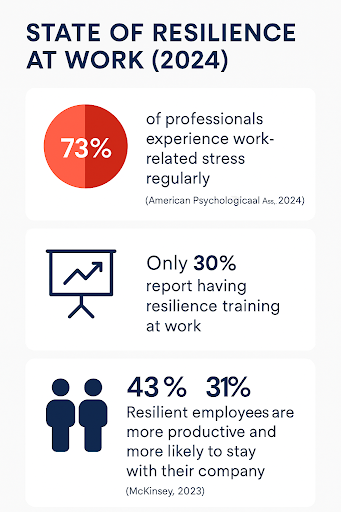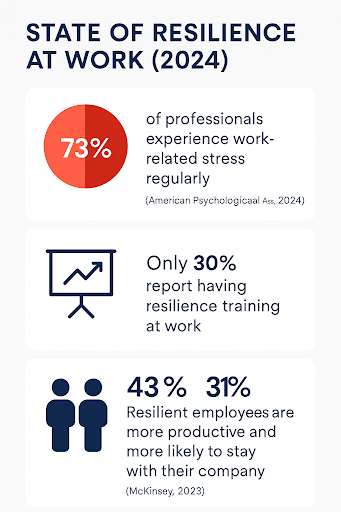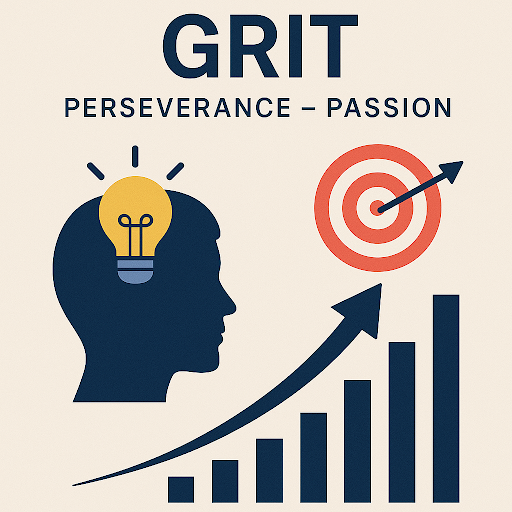Bison instinctively know that walking into the storm helps them get through it faster. This powerful insight teaches us something profound: Avoiding adversity only prolongs it.
Facing challenges head-on is how you build resilience—the inner strength to withstand pressure, bounce back from setbacks, and emerge stronger. In today’s world of fast-paced change and rising uncertainty, resilience isn’t a luxury—it’s a necessity.
What Is Resilience and Why Does It Matter?
Resilience is the ability to recover quickly from difficulties and continue performing effectively under stress. Whether you’re a student, leader, entrepreneur, or creative professional, resilience:
- Keeps you productive during crisis
- Supports mental and emotional health
- Enables faster recovery from burnout or failure
- Enhances decision-making under pressure
State of Resilience at Work (2024)
The concept of resilience has evolved from a psychological trait into a critical workplace competency. As organizations worldwide face economic uncertainties, technological disruption, and increasing employee these three data points reveal significant insights into the modern workforce.
burnout,

73% of Professionals Experience Work-Related Stress Regularly
With nearly three out of four professionals reporting regular stress, the modern workplace is increasingly seen as a pressure cooker rather than a productivity hub.
Contributing factors may include:
- Unmanageable workloads
- Lack of job security
- Poor leadership or communication
- Remote work isolation and digital fatigue
While stress itself isn’t always harmful, unmanaged or prolonged stress can lead to burnout, decreased immunity, and reduced cognitive performance, according to the APA.
Only 30% of Employees Report Having Resilience Training at Work
This gap between recognition and action is a critical oversight in workforce development strategies.
Resilience training programs often cover:
- Cognitive-behavioral tools for reframing negative thoughts
- Stress management techniques (e.g., mindfulness, time prioritization)
- Emotional regulation strategies
- Techniques to enhance adaptability and agility in change-driven environments
Resilient Employees are 43% More Productive and 31% More Likely to Stay with their Company
These statistics make a strong business case for investing in employee resilience. Resilient employees demonstrate higher cognitive flexibility, enabling them to make better decisions under pressure.
- They maintain motivation and performance even when external conditions deteriorate.
- Organizations with resilience-building frameworks tend to report lower attrition rates, reducing costly recruitment and retraining cycles.
How to Build Resilience: Face the Storm Like a Bison
| Strategy | Description | Action Steps |
| 1. Reframe Setbacks | Turn failures into opportunities for growth. | – Ask: What can I learn from this? – Shift from “Why me?” to “What next? |
| 2. Control the Controllables | Focus energy on what you can influence—your effort, response, and mindset. | – Let go of outcomes you can’t control – Channel energy into action, not anxiety |
| 3. Build Mental Fitness | Train your mind like you train your body. | – Practice mindfulness or meditation – Journal regularly – List 3 daily gratitude |
| 4. Stay Connected | Foster relationships to boost emotional resilience. | – Lean on your support system – Talk to mentors, colleagues, or friends – Seek help when needed |
| 5. Prepare, Don’t Panic | Anticipate challenges and rehearse your responses. | – Create “pressure playbooks” – Role-play stressful scenarios – Build a self-care routine |

Case Study: Angela Duckworth’s Grit Research – The Science Behind Resilience
Overview – Psychologist Angela Duckworth introduced grit—a blend of perseverance and passion—as a key predictor of long-term success, offering critical insight into resilience under pressure.
Objective – Her research explored why some thrive despite setbacks while others with higher potential falter, aiming to measure the non-cognitive drivers of success.
Key Findings
- Grit beats IQ: Gritty students often outperform more intelligent peers.
- Effort > Talent: Success depends more on sustained effort than innate ability.
- Consistency matters: Long-term goal pursuit predicts success (e.g., West Point cadets).
Implications – Grit fosters resilience by:
- Reframing failure as growth
- Building mental toughness
- Encouraging bounce-back behaviour

Building resilience isn’t just a personal habit—it’s a competitive advantage for organizations. Forward-thinking companies increasingly prioritize resilience training as a core element of employee wellbeing strategies. By equipping teams with the tools to manage stress, adapt to change, and bounce back from setbacks, businesses see measurable benefits including lower burnout rates, improved team morale, and greater adaptability in today’s fast-evolving markets. Investing in resilience not only enhances individual performance but also strengthens organizational agility and long-term success.
Let’s remember….
Bison don’t wait for the storm to pass—they walk through it. You can too. Whether you’re facing failure, burnout, or uncertainty, resilience helps you move forward faster and stronger.
Don’t wait for things to change.
Sources
- American Psychological Association (n.d.) Building your resilience. Available at: https://www.apa.org/topics/resilience/building-your-resilience (Accessed: 29 April 2025).
- American Psychological Association. (2024). 2024 Work in America Survey. [online] Available at: https://www.apa.org/pubs/reports/work-in-america/2024/2024-work-in-america-report.pdf. [Accessed 29 Apr. 2025].
- Digital Promise (2019) The Research Behind the TED Talk: Angela Duckworth on Grit. Available at: https://digitalpromise.org/2019/03/06/research-behind-ted-talk-angela-duckworth-grit/ (Accessed: 29 April 2025).
- McKinsey & Company. (2023). Developing a resilient, adaptable workforce for an uncertain future. [online] Available at: https://www.mckinsey.com/capabilities/people-and-organizational-performance/our-insights/developing-a-resilient-adaptable-workforce-for-an-uncertain-future. [Accessed 29 Apr. 2025].
- National Bison Association (n.d.) The Bison Advantage. Available at: https://nationalbison.org/the-bison-advantage/#:~:text=While%20bison%20are%20similar%20in,out%20of%20the%20weather%20quicker (Accessed: 29 April 2025).

